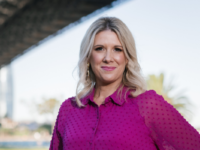Enterprise: Curious Thing
Why they stand out: A pivot from talent acquisition to customer engagement in 2021 led the AI voice company to 1340 per cent year-on-year revenue growth since inception and a place in the Top 5 Rising Stars at the Deloitte Technology Fast 50 awards.
Sam Zheng started Curious Thing with his co-founders David Mckeague and Dr. Han Xu in 2018. Having been in the natural language processing space for a long time, the trio saw the limitations of today’s intent-matching AI framework. “This is the reason why most chatbots customers see today are designed to answer simple questions – the AIs are not curious at all,” Sam avers.
“Instead of answering questions like ‘What’s the weather today?’, we thought, can we build an AI that is designed to ask open-context questions and, importantly, derive insights from people?” he explains. “That’s why we started the Curious Thing journey, to create the AI for asking questions, with the curiosity to discover and learn.”
The team describe Curious Thing as a voice AI because a voice phone call can be proactive and prompt customers to share more. They understood that people are more likely to share if they are talking.
“Passively responding to customers’ needs is simply not good enough.”
Helping businesses reimagine B2C communication is the core of Curious Thing’s mission. Sam and his team saw an increasing misalignment between customer expectation and what businesses were able to deliver when communicating with customers. “In the past, businesses usually dealt with a static view of customer touch points,” he explains. “Today, passively responding to customers’ needs is simply not good enough; businesses have to proactively engage and curiously discover insights about customers.”
The founders describe Curious Thing as the voice AI for proactive customer care. In the health sector, their technology is used for daily check-ins on patients. They did a lot of work on COVID patients for state governments. “Our AI would give individuals a call to ask them questions to understand their situation and symptoms, so that clinicians could rapidly get people onto the right support pathway,” Sam says.
Another organisation is using Curious Thing’s AI to help people quit smoking and not relapse. In financial services and fintech, Curious Thing is used across the customer journey for tasks such as onboarding assistance, information validation, payment reminders, and lapsed customer feedback collection.
Since inception, Curious Thing has experienced 1340 per cent year-on-year revenue growth and has been recognised among the Top 5 Rising Stars at the Deloitte Technology Fast 50 awards for 2021. In 2021, the company processed over three million minutes of AI-human conversations through the platform, and in May 2022, it closed a $7 million pre-series A funding round.
Curious Thing serves a slew of Australian clients, including Quitline, Calvary, Medibank, Brighte, Humm Group and a number of state and local governments. It has grown its core team in Australia to over 30 employees, with additional team members located in the US.
This growth has come on the back of a pivot beyond the original talent acquisition focus the team made in 2021. The team launched the business with a focus on using Curious Thing’s software for job interviews. That had been working well but the team felt that it was not in as high demand as they’d hoped when the company started. “It became clear there were bigger commercial opportunities if we pivoted our focus from HR tech into customer engagement,” Sam explains. “With the market trending in a very different direction, with everyone talking about talent shortages and companies changing how they viewed candidate assessment altogether, it wasn’t the ideal time to be selling an assessment tool and there were smarter opportunities to work with big clients in a much bigger way with customer calls.”
The trio are continuing to build the technology team and fuel Curious Thing’s expansion overseas. “With the voice AI category we’re in still very new, being able to continuously build the technology and the tech team is strategically important,” Sam says.
This article first appeared in issue 37 of the Inside Small Business quarterly magazine
















